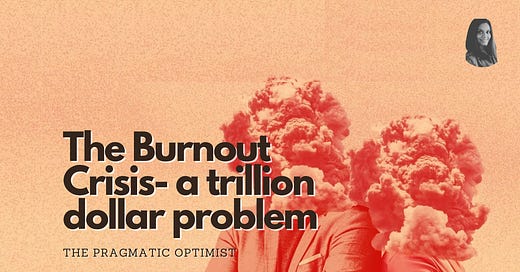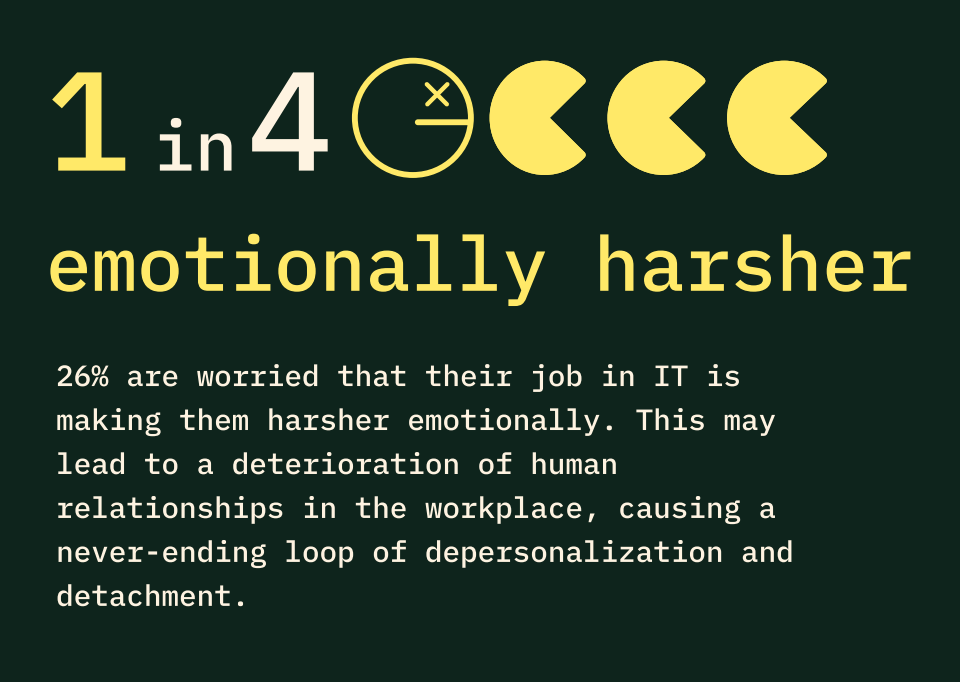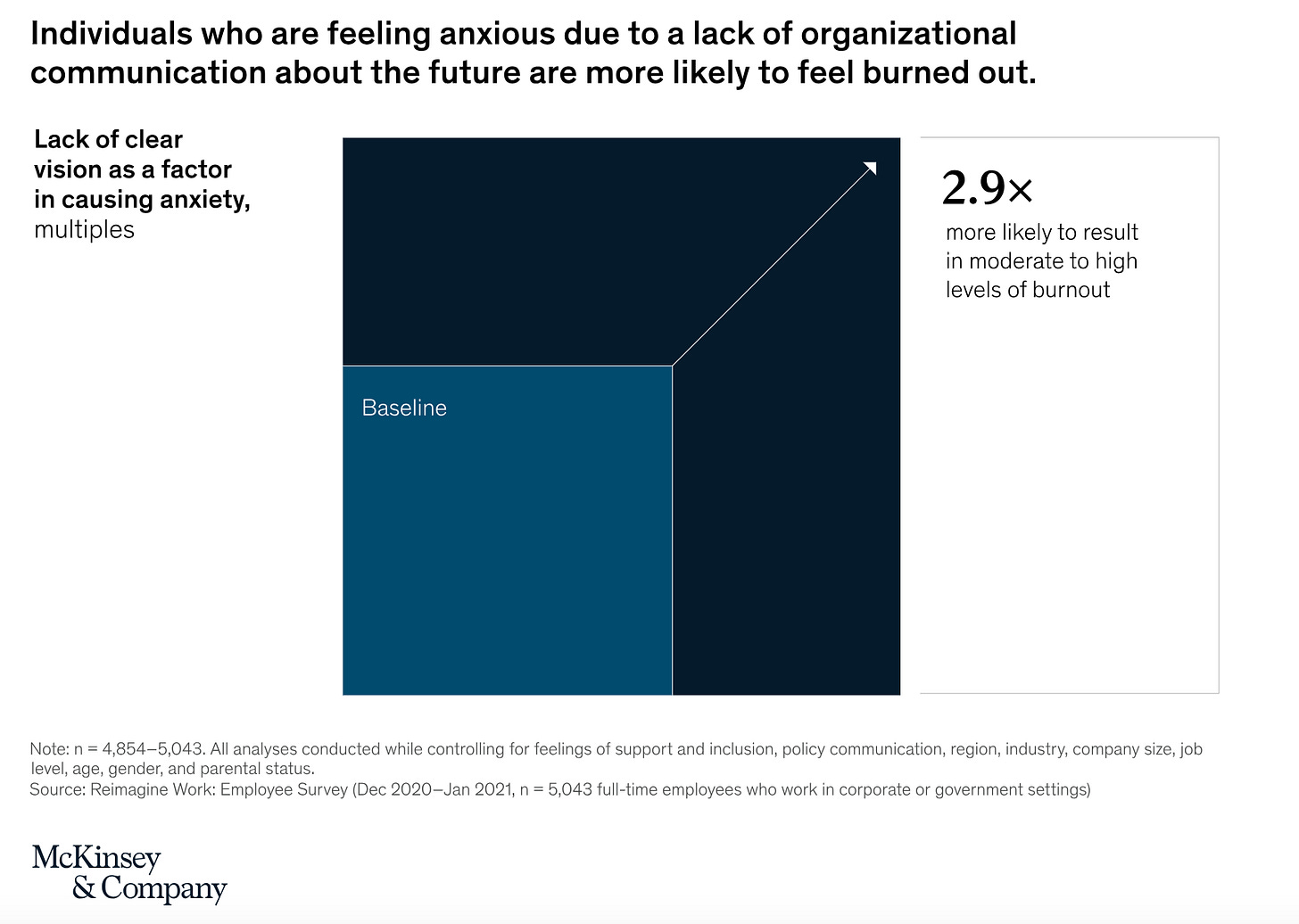The burnout crisis: A trillion dollar problem
A personal story, quantifying the burnout crisis with industry stats & what companies are doing to boost employee wellbeing
At a glance
In 2019, I burnt out. After several years of working in tech in the Bay Area, I decided to quit my high paying job and reset.
I was feeling uninspired. My creative juices were running out. My health was deteriorating.
3 years later, I am more self aware and emotionally mature. I have reclaimed my health through an active lifestyle and natural foods. I prioritize spending time with loved ones more so than ever. I am kinder and more compassionate.
I am optimistic about the world we live in and what lies ahead for me.
I did some research to quantify the magnitude of the burnout phenomenon and understand its impact on the workforce in the US. The statistics shocked me. The US has a real burnout crisis. Turns out, it affects 40% of all tech workers, and half of them are considering quitting their jobs in 6 months.
Women are more likely to feel burnt out than men.
Further, WHO estimates a $1trillion of productivity loss that results annually from some form of employee burnout.
Yet, there remains a case for optimism. Companies that are actively communicating about their vision for success and their policy for productivity, support and inclusion are seeing boosted morale in their employees and higher productivity as a result.
My inspiration for writing this post
Last week, Lenny Rachitchisky had an extensive conversation with Andy Johns on his podcast.
The title of the podcast: When enough is enough.
Andy is a former tech exec and VC, and during the podcast, he shared his story of his burnout during his career.
It was one of the most heartfelt episodes that I ever watched on Lenny’s podcast. In a world where high performers are constantly chasing superior outcomes, people rarely talk about the “burnout” that results from the chase and how best to cope with it.
So, thank you
and Andy for bringing the topic front and center.Inspired by the podcast, I decided to share my story of burnout with all of you. The podcast also inspired me to do some research on industry stats on burnout, how it manifests in human beings, and the impact it has on productivity, which I will also share with you.
My story: From burnout to building my new life with purpose and intention
In 2014, I was excited to start my journey in tech. I was inspired and thrilled by the startup culture in the Bay Area and I wanted to play my part in it as well.
I learnt a lot, worked very hard and made some lifelong friends. Plus, the money was great.
In 2019, I burnt out.
I felt that after all these years, I had reached a peak in my growth trajectory.
I could choose to move to another company for a higher pay.
But the utility of a 20% or so increase in salary was not enticing to me anymore.
Furthermore, I held an H1B work visa which left me no room to experiment professionally at all.
I was feeling uninspired. My creative juices were running out. My health was deteriorating.
So, I decided to quit my role. And a few months later, I left the Bay Area and the country.
I had no idea what my next profession was going to be.
And it was scary!
I must also say that being an Indian, where the culture is deeply rooted in hard work, perseverance and loyalty, I had my fair share of self doubt.
Despite all odds, I decided to embark on my journey to heal from my burnout and rebuild my life with intention.
And 3 years later…
✅I am more self aware and emotionally mature than I was 3 years ago.
✅I have reclaimed my health through an active lifestyle and natural foods.
✅I prioritize spending time with loved ones more so than ever.
✅I am kinder and more compassionate.
✅I am optimistic about the world we live in and what lies ahead for me.
How big a problem is burnout? Let’s look at some stats
Inspired by Lenny’s podcast with Andy Johns, I did some research and dug out some industry wide stats on burnout.
And I am shocked at the magnitude of the burnout phenomenon.
In fact, it looks more like a burnout “crisis” to me.
Yes, the US has a real burnout crisis in tech and WHO estimates that $1 trillion is lost in productivity as a result.
First, let’s look at the stats from an eagle’s eye view point.
According to The State of Burnout in Tech 2022, out of 32,644 tech workers surveyed, 40% show a high risk of burnout.
In the same survey, 42% of IT professionals with high levels of burnout risk are considering quitting their company in the next 6 months.
Women have a higher burnout risk than men.
The four dimensions of behavior that point to a higher risk of burnout
According to a study by The State of Burnout in Tech 2022 , burnout is best represented in a 4 dimensional model, which includes
Emotional or energetic exhaustion
Professional self inefficacy
Cynicism
Depersonalization
1. Emotional or Energetic Exhaustion
This is the most common vector of burnout attack on tech workers.
Emotion and/or Energetic Exhaustion is manifested when individuals are unable to unwind, recover and restore energy for the next day.
This leads to fatigue, depression, cardiovascular problems and other stress-related illnesses.
According to the survey, 56% of all IT workers claimed that they can’t unplug once their workday is over and 62% feel emotionally drained.
Furthermore, women are more emotionally drained out than men (shown in the chart below).
2. Professional Self-inefficacy
Professional self-inefficacy or imposter syndrome manifests when workers lack confidence in themselves or what they do.
This eventually leads to lower productivity and low employee morale.
According to the survey, 51% of all tech workers feel like they are achieving less than they should and 33% feel inefficient at their job.
In the graph below, I have shown how the sense of efficacy and accomplishment differs amongst team leaders and subordinates.
We would think that team leaders would have a greater sense of self-efficacy and accomplishment. Turns out there is not a significant difference between the team leaders and subordinates in their perception.
3. Cynicism
Cynicism is a tricky vector of attack as this manifests in erratic behavior in the individual.
The individual no longer finds satisfaction or meaning in the work they do.
As a result, productivity declines rapidly. As per the report, cynicism is the biggest predictor of employee turnover.
Individual contributors report higher cynicism than the team leaders. Also, 30% of individual contributors don’t know their purpose or value, compared to 24% of team leaders who report the same.
4. Depersonalization
Depersonalization is the final frontier where the individual shuts down emotions to cope and continue working.
An extension of cynicism, the individual lacks a sense of community and turns cold and distant towards colleagues and clients.
26% of tech workers claim their work is making them harsher emotionally, leading to reduced capability of making meaningful human connections.
This has devastating implications for the individual’s health, company reputation and overall productivity
Health compromised:
Burnout or workplace stress costs $125-$190 billion annually in healthcare spending. It also contributes to 120,000 deaths per year.
Company reputation under risk:
57% of workers with high risk of burnout are detractors, in other words, they are highly likely to leave negative feedback on social media or other platforms, thus hurting company reputation.
Poor productivity:
According to WHO, $1 trillion is lost in productivity each year as a result of some form of burnout.
A burnt out worker is likely to have low morale, poorer performance, and high absenteeism. This will lead to lower than optimal productivity.
But let’s not forget the second and third order effects.
A burnt out person can bring down the overall morale of his colleagues, thus damaging company productivity at a larger scale. In fact, 95% of HR leaders agreed in the Kronos survey that burnout was sabotaging workforce retention.
Even after the individual leaves the company, hiring managers may face difficulty acquiring new talent, especially if the employee has left negative feedback, damaging the company’s reputation.
Organizations with clearer communication are seeing benefits to employee well-being and productivity
There is reason for optimism after all.
A recent study by McKinsey showed that individuals are 2.9x times more likely to burnout when there is a lack of organization communication about the future.
In the same study, they found that organizations with clear communications around vision and policies on productivity, support and inclusion are seeing improvement in employee well-being and productivity.
Employees choose hybrid over on-site moving forward
The employees have spoken as well.
According to the McKinsey report, the majority of employees would like to work from home at least three days per week in the future.
Employees with young children are the most likely to prefer flexible work locations.
In fact, if companies choose to go on-site without offering any flexible work arrangements, there may be significant talent implications, with 30% of surveyed employees indicating that they would likely switch jobs in that scenario.
Connecting the dots together…
The burnout crisis is real.
It affects 40% of all tech workers, and half of them are considering quitting their jobs in 6 months.
Women are more likely to feel burnt out than men.
Burnout has serious consequences.
Burnout leads to severe health problems in individuals.
It hurts employee retention and may also sabotage employee acquisition if the company reputation is damaged as a result of negative feedback on social platforms by burnt out individuals.
There is an estimated $1trillion of productivity loss that results annually from some form of employee burnout according to WHO.
Yet, there remains hope for both companies and employees to work together to find common grounds where there is a win-win for all.
Companies that are actively communicating about their vision for success and their policy for productivity, support and inclusion are seeing boosted morale in their employees and higher productivity as a result.
Employees are demanding flexible work arrangements. And companies that are listening to their employees and working with them to build sustainable solutions around work-life will have more productive employees, higher NPS scores and great prospects for new talent acquisition.
My final thought: At the end of the day, we have to learn to own our own mental health. This is an active journey of dedicating time to self-reflect, refuel our bodies, reset boundaries with people and technology and reconnect with our loved ones.
That’s all for today!!!
Hope you enjoyed this piece. I will be forever grateful if you choose to spread the love by liking, commenting or sharing with your network.
Amrita















Thank you for raising these important points. Good stuff!
Great and relevant post, Amrita.
I too burned out after a two-decade career as an executive in post-secondary education. The good news is it led to the my present career as an investment newsletter writer and nonfiction author. And as you wrote so eloquently, my health and well-being has also improved dramatically.
Stay well and keep writing!